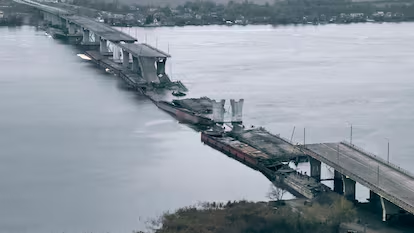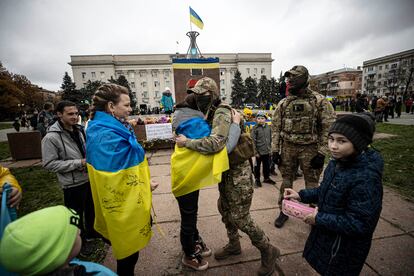Ukraine opens a new front on the Dnipro to threaten Moscow’s rearguard
Kyiv’s special forces are intensifying amphibious assaults in the Kinburn estuary at the mouth of the Black Sea, a possible diversionary tactic or preparation for a full-scale landing

Ukraine believes it has identified the Achilles heel in Russia’s defensive positions on the Dnipro River. This weak point is located on the Kinburn Peninsula, an enclave of high ecological value in the estuary formed by the Dnipro and the Bug River on the coast of the Black Sea. Before the war it was an area popular with ecotourism lovers; now it is occupied by Russian forces and the scenario for a campaign of fleeting Ukrainian attacks that military experts see as a new chapter in the conflict – one of amphibious guerrilla tactics.
Moscow’s troops last week abandoned Kherson in the face of Kyiv’s counter-offensive and retreated to the eastern bank of the Dnipro, where they fortified their defensive positions and extended the line by over 60 miles. The High Command of the Armed Forces of Ukraine plans to keep pushing its advantage on the Kherson front by landing troops on the far bank of the Dnipro, although this will not happen until Kyiv has built up sufficient units, equipment and artillery power, Major-General Dymytro Marchenko told the BBC two weeks ago.
Military personnel and analysts consulted by EL PAÍS warn that it will be months before the conditions are optimal for Kyiv to launch a large-scale troop landing on the eastern bank of the Dnipro. Thibault Fouillet, a former artillery officer who is now an analyst at French think-tank the Foundation for Strategic Research, says the operation will be the most difficult of the war so far for Ukrainian forces. “Three or four months ago I would not have even considered the feasibility of something like that, but now I cannot rule it out: it will depend on whether or not the Russians hold their positions on the river.”
Kyiv’s intelligence services and those of western allies including the UK have reported over the past few weeks that morale among Russian troops is low. Last week, a video of an elite Kremlin unit stationed south of the city of Kherson was broadcast on pro-Russian Telegram accounts, in which they claimed that they had been forced to abandon their positions due to a lack of weapons needed to protect themselves from Ukrainian artillery strikes. The location of these soldiers, which was not specified, was near the estuary formed by the Dnipro and the Bug. In this area, Russian fortifications are not as extensive as those erected along the stretch of the river from Kherson northward to the province of Zaporizhzhia. On November 18, the Ukrainian Southern High Command published images of a Russian barracks in Kinburn that had been completely destroyed by artillery.
On the final stretch of the Dnipro before it meets the Black Sea, nature is Russia’s greatest defensive tool. In this area, the river reaches widths of almost five miles, if the marshy waters on either side are taken into account. The shortest point between the two banks is the Kinburn Spit, a narrow strip of land on the eastern side of the river, a little over two miles from the opposite bank in the municipality of Ochakiv, which is under Ukrainian control. “This large territory, dominated by lush vegetation and lagoons, has low accessibility for transport and has not been fully controlled by either side,” Rybar, a pro-Kremlin military analysis group, noted on November 15.
Rybar claims that landing attempts by Ukrainian reconnaissance units have been ongoing since last spring. These operations had not been publicized by Kyiv, until now. After the liberation of Kherson, Ukrainian military accounts, including that of the Ministry of Defense, have published videos on social networks of marine units sailing in speedboats on the Dnipro. The Ukrainian High Command reported firing more than 50 artillery shells at Russian defensive positions in Kinburn on November 15. Early the previous morning, the Russian military administration in the area reported thwarting the landing of special forces units attached to the 73rd Naval Special Purpose Center, based in Ochakiv.
The provincial government of Mykolaiv confirmed that early that same morning the Ochakiv district had been targeted with unusual intensity by Russian artillery. The Ukrainian High Command in Mykolaiv denied EL PAÍS access to the locality, claiming that military operations are underway.

Kyiv’s tactics could be a feint to draw Russian troops south
French General Jérôme Pellistrandi said during an interview with this newspaper that the terrain in Kinburn is not favorable for landings with amphibious armored vehicles, nor for large numbers of troops or for the movement of heavy artillery. “It is interesting for special forces operations, for small groups that strike with amphibious guerrilla tactics,” he noted. Pellistrandi, who regularly provides analysis in the French media, adds that Ukraine is a long way from having a large enough fleet of suitable boats for a full-scale landing: “This costs a lot of money and takes a lot of time.”
Mike Martin, a researcher at the Department of War Studies at King’s College London, said last week on Twitter that Ukraine may be staging a diversionary operation in Kinburn to draw Russian troops away from the Zaporizhzhia front. Robin Häggblom, a Finnish defense analyst, published a report on November 14 that also concluded Ukrainian forces are attempting to open a new front against Russian forces, without the need to move their own artillery, which can operate from the opposite side of the Dnipro. “If the Ukrainian light infantry starts moving quickly in gaps behind the frontline, the Russians will have to take action. And that might be the whole point. If Russia starts to shift serious forces south, that might open up possibilities on other fronts, such as finding a nice less-than-well-guarded position for a river crossing,” Häggblom wrote.
Russian military strategists view the situation in much the same way, as noted by Rybar: “The Ukrainian High Command will most likely focus its efforts not on the physical seizure of the Kinburn Peninsula, but on increasing the operations of its saboteur groups. The goal is to force the reaction of the Russian forces in the area, disrupt supplies to their defensive fortifications and create the conditions for wider attacks on Russian territory.”
However, Kinburn holds strategic value that goes beyond the reconquest of areas occupied by Moscow. Fouillet notes that if Russia studies the option of crossing back into western Ukraine, the estuary may be key to supporting its Black Sea fleet. Alexei Kondratiev, commander of the Russian Don Cossacks brigade, said during an interview in October that Kinburn is strategically important to Moscow because it is the westernmost position reached by Russian forces in Ukraine, lying just 32 nautical miles from Odesa. It is also essential for Ukrainian strategy because Kinburn controls river traffic on the Bug, which connects Mykolaiv to the Black Sea.
Sign up for our weekly newsletter to get more English-language news coverage from EL PAÍS USA Edition
Tu suscripción se está usando en otro dispositivo
¿Quieres añadir otro usuario a tu suscripción?
Si continúas leyendo en este dispositivo, no se podrá leer en el otro.
FlechaTu suscripción se está usando en otro dispositivo y solo puedes acceder a EL PAÍS desde un dispositivo a la vez.
Si quieres compartir tu cuenta, cambia tu suscripción a la modalidad Premium, así podrás añadir otro usuario. Cada uno accederá con su propia cuenta de email, lo que os permitirá personalizar vuestra experiencia en EL PAÍS.
¿Tienes una suscripción de empresa? Accede aquí para contratar más cuentas.
En el caso de no saber quién está usando tu cuenta, te recomendamos cambiar tu contraseña aquí.
Si decides continuar compartiendo tu cuenta, este mensaje se mostrará en tu dispositivo y en el de la otra persona que está usando tu cuenta de forma indefinida, afectando a tu experiencia de lectura. Puedes consultar aquí los términos y condiciones de la suscripción digital.
More information
Archived In
Últimas noticias
Most viewed
- David King, chemist: ‘There are scientists studying how to cool the planet; nobody should stop these experiments from happening’
- Reinhard Genzel, Nobel laureate in physics: ‘One-minute videos will never give you the truth’
- Mexico completes its trade shift with the entry into force of tariffs on China and countries without trade agreements
- Oona Chaplin: ‘I told James Cameron that I was living in a treehouse and starting a permaculture project with a friend’
- Sinaloa Cartel war is taking its toll on Los Chapitos









































